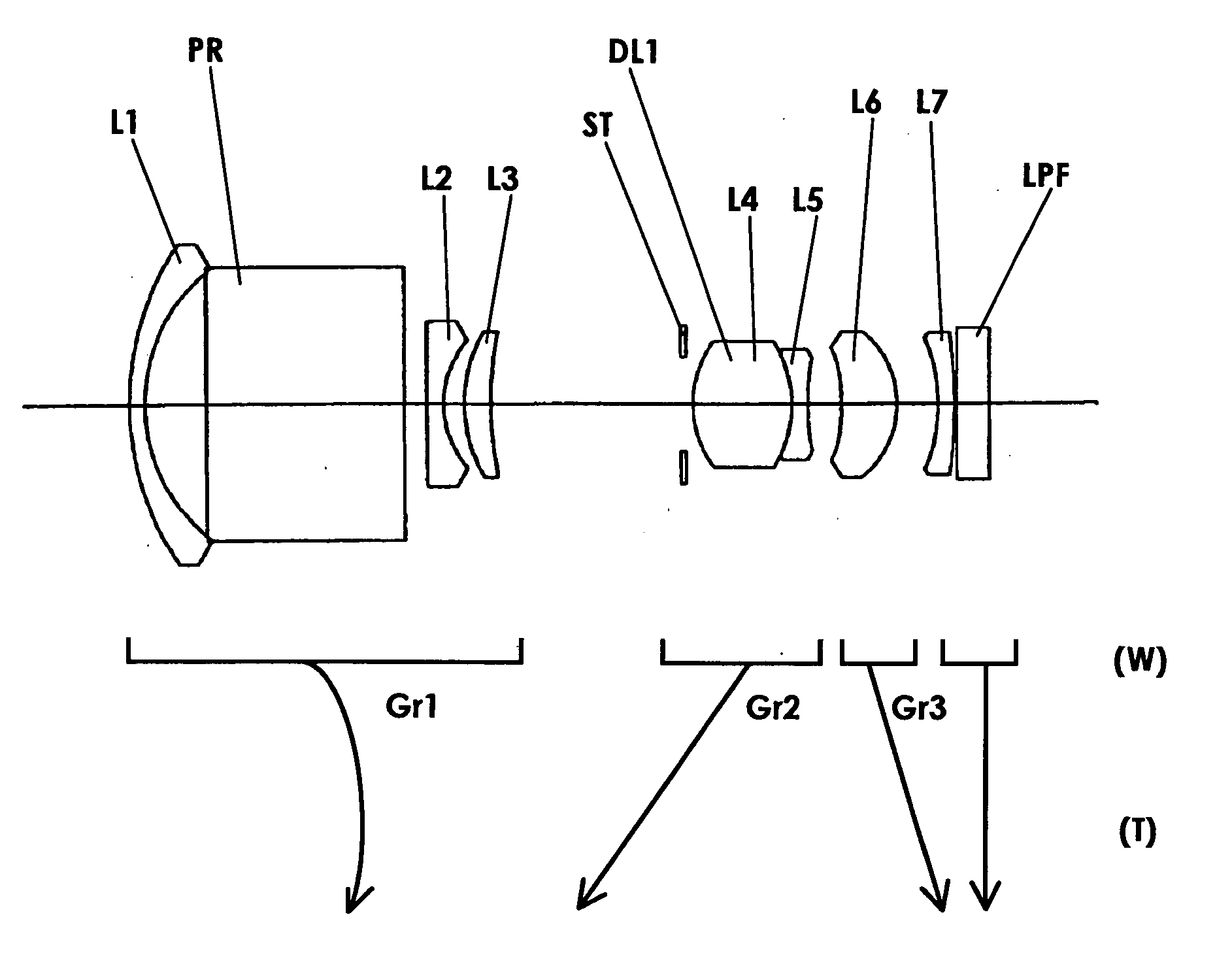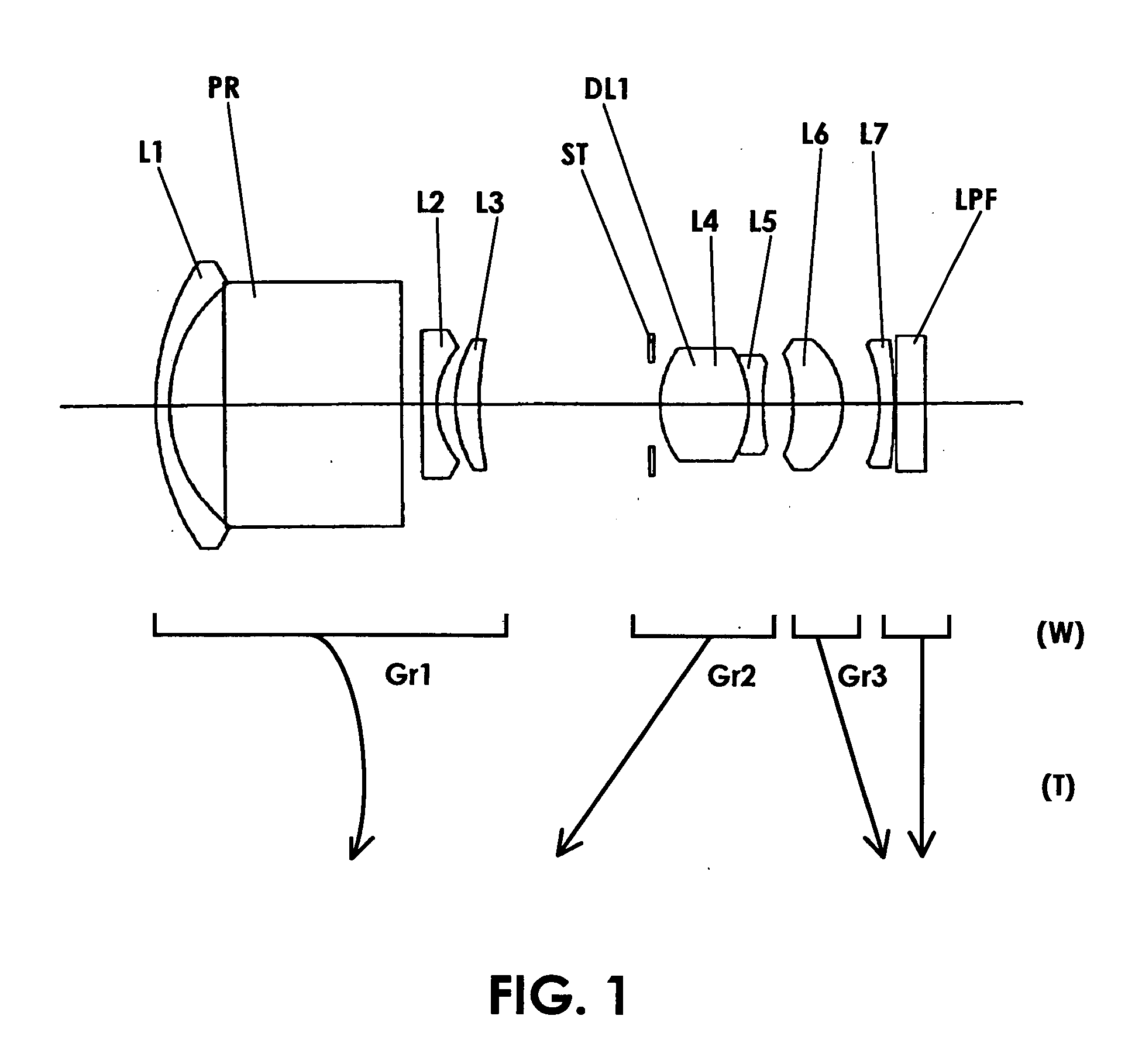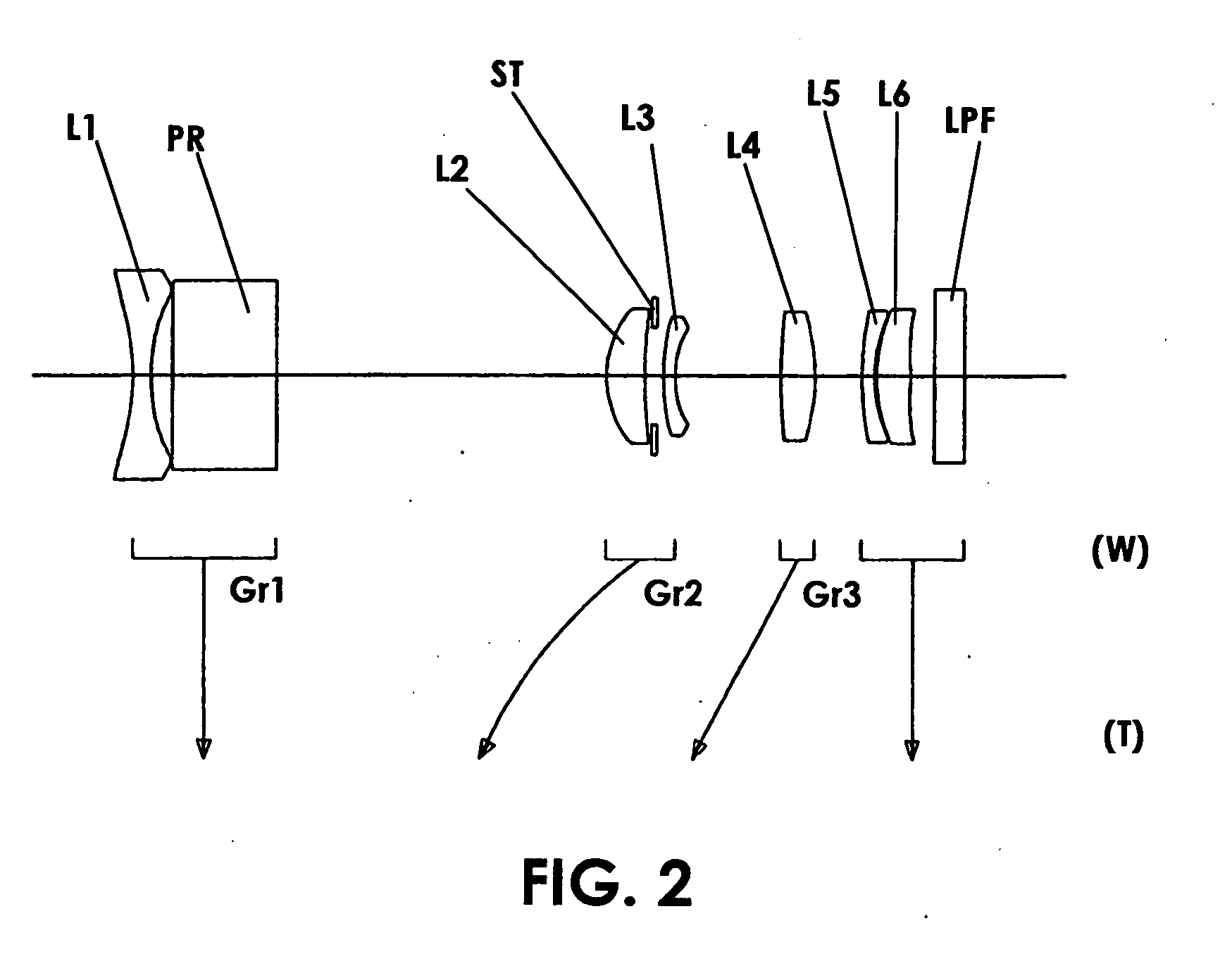Imaging device and digital camera using the imaging device
a technology of imaging device and lens barrel, which is applied in the direction of camera filters, instruments, television systems, etc., can solve the problems of insufficient security of peripheral light, inability to secure the optical performance of image sensors, and difficulty in setting the pupil of the microlens, so as to reduce the cost of imaging devices, improve the degree of freedom of lens barrel structure, and thin optical systems
- Summary
- Abstract
- Description
- Claims
- Application Information
AI Technical Summary
Benefits of technology
Problems solved by technology
Method used
Image
Examples
example 2
[0075]
2 f = 5.8 - 11.6 - 16.7 Fno. = 3.60 - 3.60 - 3.66 [Radius of [Axial [Refractive [Abbe Curvature] Distance] Index (Nd)] Number (vd)] r1* = -11.725 d1 = 1.200 N1 = 1.49310 v1 = 83.58 r2* = 13.872 d2 = 1.410 r3 = .infin. d3 = 7.000 N2 = 1.84666 v2 = 23.82 r4 = .infin. d4 = 22.033 - 8.278 -0.600 r5 = 6.671 d5 = 2.562 N3 = 1.75450 v3 = 51.57 r6 = 35.072 d6 = 0.600 r7 = .infin. d7 = 0.600 r8* = 18.236 d8 = 0.800 N4 = 1.84666 v4 = 23.82 r9* = 8.198 d9 = 7.034 -16.244 - 14.414 r10 = 39.487 d10 = 2.334 N5 = 1.49310 v5 = 83.58 r11 = -13.184 d11 = 3.125 - 7.669 - 17.177 r12 = 21.757 d12 = 0.800 N6 = 1.84666 v6 = 23.82 r13 = 9.428 d13 = 0.175 r14 = 10.828 d14 = 2.272 N7 = 1.50467 v7 = 59.44 r15* = -70.639 d15 = 1.665 r16 = .infin. d16 = 2.000 N8 = 1.51680 v8 = 64.20 r17 = .infin. [Aspherical Coefficient] r1* .epsilon. = 0.10000E+01 A4 = 0.39770E-03 A6 = 0.48251E-05 A8 = -0.13574E-06 A10 = 0.82447E-09 r2* .epsilon. = 0.10000E+01 A4 = 0.12088E-03 A6 = 0.37656E-05 A8 = 0.23199E-06 A10 = -0.7...
example 3
[0076]
3 f = 6.0 - 12.0 - 17.3 Fno. = 3.60 - 3.60 - 3.60 [Radius of [Axial [Refractive [Abbe Curvature] Distance] Index (Nd)] Number (vd)] r1* = -72.486 d1 = 1.200 N1 = 1.49310 v1 = 83.58 r2* = 8.054 d2 = 2.476 r3 = .infin. d3 = 9.000 N2 = 1.84666 v2 = 23.82 r4 = .infin. d4 = 21.244 - 4.060 -0.600 r5 = 6.766 d5 = 2.652 N3 = 1.79719 v3 = 45.34 r6 = 17.430 d6 = 1.000 r7 = .infin. d7 = 0.686 r8* = 93.830 d8 = 0.800 N4 = 1.84666 v4 = 23.82 r9* = 12.440 d9 = 3.714 -12.381 - 9.898 r10 = 22.538 d10 = 2.473 N5 = 1.49310 v5 = 83.58 r11 = -15.873 d11 = 1.500 - 9.644 - 21.642 r12 = -11.841 d12 = 0.800 N6 = 1.84666 v6= 23.82 r13 = -27.408 d13 = 0.100 r14 = 16.037 d14 = 2.349 N7 = 1.72904 v7 = 52.47 r15* = -57.477 d15 = 6.683 - 7.055 - 1.000 r16 = .infin. d16 = 2.000 N8 = 1.51680 v8 = 64.20 r17 = .infin. [Aspherical Coefficient] r1* .epsilon. = 0.10000E+01 A4 = -0.24017E-05 A6 = 0.29455E-05 A8 = -0.30412E-07 A10 = 0.12502E-10 r2* .epsilon. = 0.10000E+01 A4 = -0.18797E-03 A6 = -0.38877E-05 A8 = 0....
example 4
[0077]
4 f = 5.8 - 11.6 - 16.7 Fno. = 3.60 - 3.60 - 3.60 [Radius of [Axial [Refractive [Abbe Curvature] Distance] Index (Nd)] Number (vd)] r1* = -14.542 d1 = 1.200 N1 = 1.49310 v1= 83.58 r2* = 12.397 d2 = 1.494 r3 = .infin. d3 = 7.000 N2 = 1.84666 v2 = 23.82 r4 = .infin. d4 = 22.039 - 8.570 -0.600 r5* = 7.238 d5 = 2.651 N3 = 1.71300 v3 = 53.93 r6 = 48.781 d6 = 0.677 r7 = .infin. d7 = 0.600 - 0.931 - 1.000 r8* = 25.723 d8 = 0.805 N4 = 1.84666 v4 = 23.82 r9* = 10.714 d9 = 6.475 - 16.205 - 14.774 r10 = 42.281 d10 = 2.322 N5 = 1.49310 v5 = 83.58 r11 = -13.537 d11 = 4.243 -7.651 - 16.983 r12 = 19.872 d12 = 0.800 N6 = 1.84666 v6 = 23.82 r13 = 8.858 d13 = 0.100 r14 = 6.329 d14 = 2.301 N7 = 1.48749 v7 = 70.44 r15* = 16.784 d15 = 0.996 r16 = .infin. d16 = 2.000 N8 = 1.51680 v2 = 64.20 r17 = .infin. [Aspherical Coefficient] r1* .epsilon. = 0.10000E+01 A4 = 0.31440E-03 A6 = 0.40741E-05 A8 = -0.13254E-06 A10 = 0.88372E-09 r2* .epsilon. = 0.10000E+01 A4 = -0.14549E-03 A6 = 0.90366E-05 A8 = 0.2359...
PUM
 Login to View More
Login to View More Abstract
Description
Claims
Application Information
 Login to View More
Login to View More - R&D
- Intellectual Property
- Life Sciences
- Materials
- Tech Scout
- Unparalleled Data Quality
- Higher Quality Content
- 60% Fewer Hallucinations
Browse by: Latest US Patents, China's latest patents, Technical Efficacy Thesaurus, Application Domain, Technology Topic, Popular Technical Reports.
© 2025 PatSnap. All rights reserved.Legal|Privacy policy|Modern Slavery Act Transparency Statement|Sitemap|About US| Contact US: help@patsnap.com



